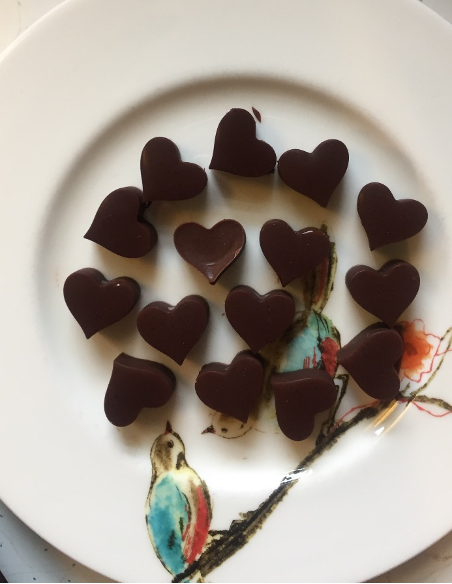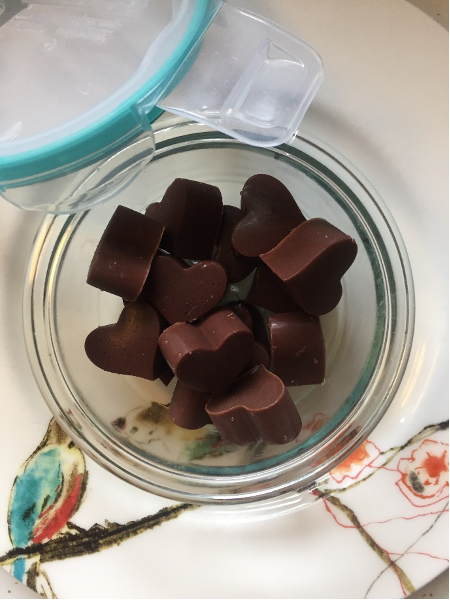Coconut Oil Chocolate Candies
Ingredients:
- 1/2 cup coconut oil
- 1/4 cup cocoa powder
- 2 tbsp organic raw honey--local is best, adjust according to taste
- 1 tsp pure vanilla extract (optional)
Directions:
- Melt the coconut oil. Don’t heat the oil too much -- just heat it enough to that it melts. Try microwaving on high for 15 seconds, then whisk, and repeat, if necessary. Coconut oil turns to a liquid state at body temperature, so it doesn’t need to be much hotter than that. The reason for this is that the hotter the liquid, the longer it will take to cool, giving the mixture more time to separate once in the mold.
- If you have a blender, combine the coconut oil and honey in the blender and blend until smooth. If you don’t have a blender, mix well using a whisk.
- Add the cocoa powder and either blend or whisk until smooth.
- Pour the mixture into an ice cube tray or mini muffin tray (silicone ones work best).
- Cool for 30 minutes in the fridge or freezer. Note: time varies depending on how hot the coconut oil was when you started. If the oil is only just reached its melting stage, these will set in as little as 15 minutes.
- Make sure to keep them in the freezer or refrigerator after making, as they melt easily in warm weather.
- Makes approximately 25 small chocolates
Adapted from: http://www.beyondthepeel.net/2012/06/coconut-oil-chocolate-recipe.html
Nutrition Facts:
Commercial chocolate, even organic dark chocolate, is traditionally a very difficult food to include in the Anti-Inflammatory Diet for IBD because it is most often sweetened with refined cane sugar. This recipe creates small, melt-in-your-mouth chocolates with only 4 easy ingredients, sweetened with honey. Local raw honey has been shown to boost immunity, help with seasonal allergies, and is a great natural alternative for a cough suppressant. The phytonutrients found in honey have been shown to possess cancer-preventing and anti-tumor properties, benefits that are largely eliminated when raw honey is extensively processed and heated. Additionally, different varieties of honey possess a large amount of friendly bacteria (up to 6 species of lactobacilli and 4 species of bifidobacteria!), making honey a great probiotic source on the IBD-AID. Look for honey produced in the summer by flower-fed bees—it's most likely to contain these friendly bacteria.
| Calories: | 45 | |
| Total Fat: | 4.5g | |
| Saturated Fat: | 3.8g | |
| Total Carbohydrate: | 1.9g | |
| Total Protein: | 0.2g | |
| Total Fiber: | 0.3g |


Image Credit: Rene Maserati
IBD-AID™ Phase I, II, and III (as tolerated)